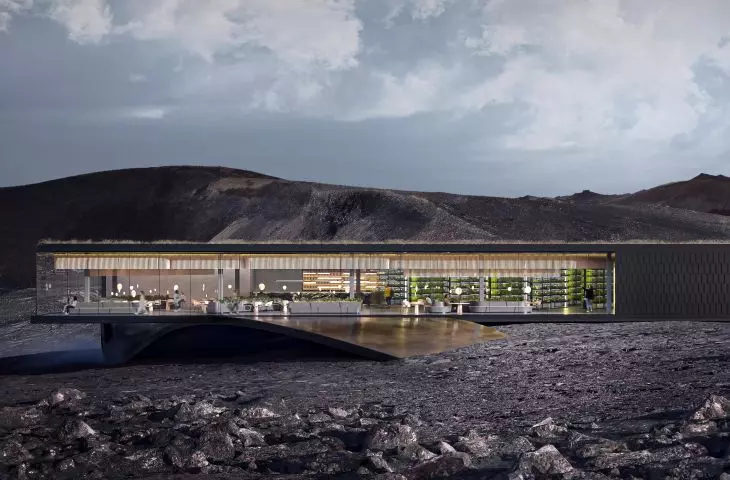The Långhus project is the result of a collaboration between Jakub Ciszewski and Tomasz Klepek, architecture students at the Silesian University of Technology, and Mikołaj Chmiel and Oskar Maly of the Sheffield School of Architecture. The concept, which combines modern design and the traditional architecture of Icelandic peat houses, competed in the Bee Breeders competition to design a restaurant-greenhouse located near Lake Mývatn and the Hverfjall volcano in Iceland.
As part of the Iceland Greenhouse Restaurant competition, participants were asked to design a greenhouse restaurant. The organizers required a comprehensive design that would serve its function year-round. The building would be constructed on the Vogafjós farm and would allow vegetables and fruits to be grown, which would then be served in the restaurant along with local products.
For detailed guidelines and the jury, we wrote about the projects Green Eden by Patrycja Ziemienowicz, Samkomuhús by Agnieszka Grzemska, Jakub Wichtowski and Jan Zieliński from UAP, and Following the terrain by Katarzyna Drągowska and Eliza Lasek from Warsaw University of Technology. All concepts were shortlisted for the project.
The body of the restaurant is a combination of the simplicity of a cuboid with a characteristic support
© Jakub Ciszewski, Mikołaj Chmiel, Tomasz Klepek, Oskar Mały
inter-university cooperation
Architecture students Jakub Ciszewski, Mikolaj Chmiel, Tomasz Klepek and Oskar Maly also competed in the Bee Breeders competition. Their project Långhus is an interesting inter-university collaboration, conducted mostly remotely.
We decided on inter-university cooperation - two of our team (Jakub Ciszewski, Tomasz Klepek) are students at the Faculty of Architecture at the Silesian University of Technology in Gliwice, while the other two (Mikołaj Chmiel, Oskar Mały) are studying at the Sheffield School of Architecture in the UK. It was an interesting experience - we conducted most of the project remotely, which was quite a challenge. In addition, we could not enter the competition itself as students either, as we were not participants of a single university, so we started as a professional team. In the initial phase, we tried to establish a common premise, the most important feature of which was to integrate a large block into the empty, cold Icelandic landscape, the authors introduce in the project.
The dining area was divided by wooden, illuminated elements on the ceiling
© Jakub Ciszewski, Mikołaj Chmiel, Tomasz Klepek, Oskar Mały
a place for rest and contemplation
The main design concept of the young architects was to create a space that is a combination of the raw, volcanic landscape and the friendly interior of the building. Wanting to emphasize this premise, the authors used a material with a basalt aesthetic on the facade, which refers to the characteristic cliffs of Iceland. Inside the building, wooden elements were juxtaposed with concrete details and complemented with greenery.
Thanks to these treatments, we have created a place for rest and contemplation intended for people coming to see the beauty of the Mývatn Lake area, the architects add.
The multifunctional space has been equipped with a system of movable walls
© Jakub Ciszewski, Mikolaj Chmiel, Tomasz Klepek, Oskar Maly
In the competition design, in addition to the restaurant, greenhouse and kitchen facilities required in the assumptions, the students also proposed a multipurpose space. This special room was equipped with a proprietary system of movable walls allowing the interior to be adapted for events taking place in it, such as conferences, film screenings, exhibitions, workshops or even yoga classes.
greenhouse inscribed in the building
The design team decided to merge the restaurant with the greenhouse, which was to become an integral part of the whole.
greenhouse melts into the restaurant
© Jakub Ciszewski, Mikołaj Chmiel, Tomasz Klepek, Oskar Mały
The "entrance" of the greenhouse to the interior of the restaurant is particularly visible in the projection. As a result, guests are surrounded by greenery, while at the same time the plant growth area is located next to the kitchen facilities, allowing the staff easy access to fresh vegetables and fruits, the designers explain.
The dining area is divided by wooden backlit elements on the ceiling, which delineate the individual tables.
Interior of the restaurant with a visible greenhouse
© Jakub Ciszewski, Mikołaj Chmiel, Tomasz Klepek, Oskar Mały
combining contrasts
The structure of the building's roof is reminiscent of Icelandic historic peat houses. In order to provide natural lighting, skylights were placed in the roof - thanks to them, even from inside the restaurant one can see the aurora borealis. The lump of the restaurant is a combination of the simplicity of a cuboid with a characteristic expressive support.
In the design, the authors wanted to combine contrasts
© Jakub Ciszewski, Mikołaj Chmiel, Tomasz Klepek, Oskar Mały
The key of our project is juxtaposition - connection/contrast. We juxtaposed contrasting shapes, a harsh exterior with a cozy interior, and heavy basalt facades with large glazing. This brings to mind the context and environment in which the project is located. The entire block has been covered with a "green mantle" so that the restaurant sinks into the Icelandic landscape, the authors conclude.











































